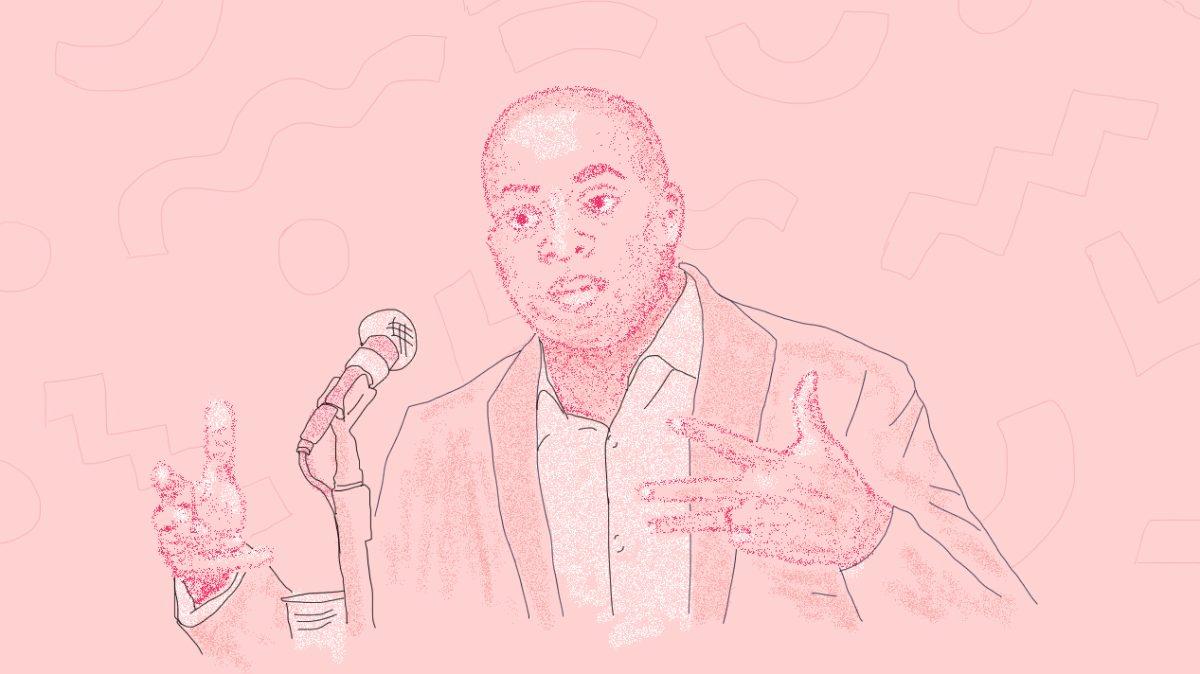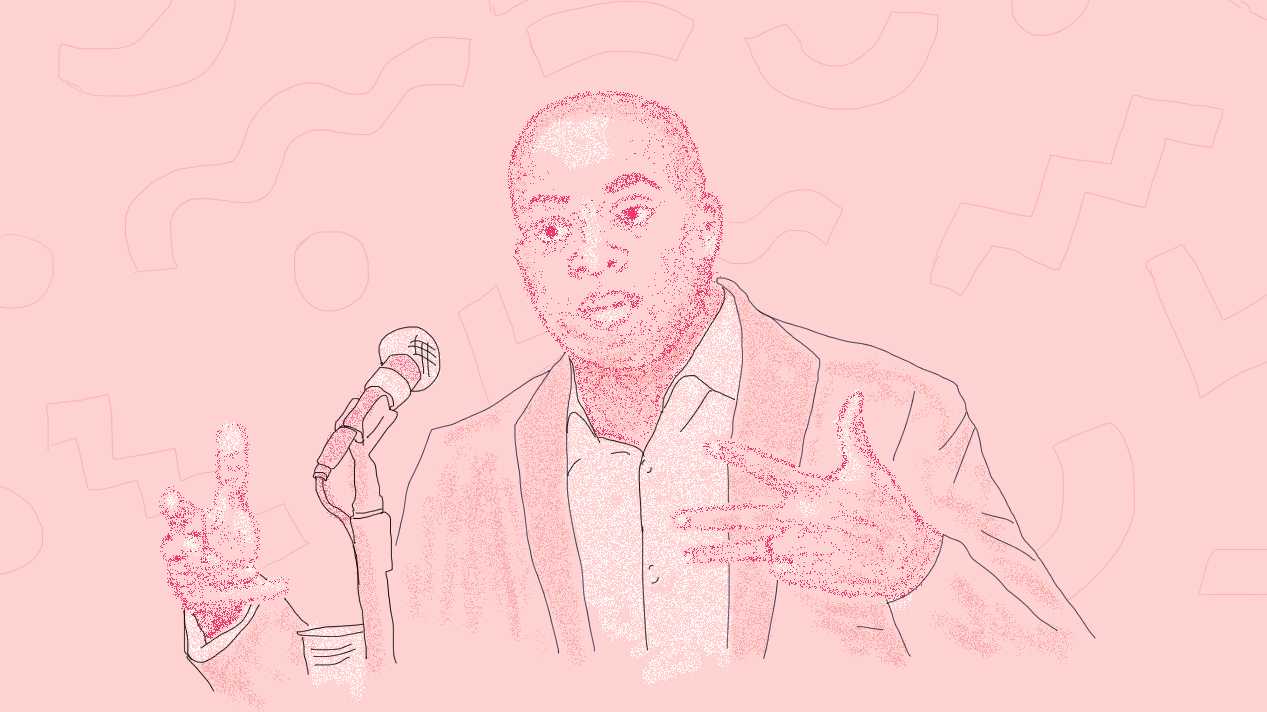University of Texas at Austin History professor, Leonard Moore, appeared at the Millennium Youth Center on Thursday, Oct. 12 to discuss access, equity and campus climate at a community chat that provoked poignant and uncompromising dialogue about UT’s involvement in the greater Austin community.
Story by Sage Foster
Illustration by Ryan Hicks
Virginia Cumberbatch, director of UT’s Community Engagement Center, began the night with a warm welcome and brief word about the university’s Division of Diversity and Community Engagement (DDCE), the organization that planned the event. Cumberbatch explained the DDCE’s mission to ORANGE, describing the division’s two spheres. “One is to address issues of equity and inclusion on campus through a multitude of programs, whether that’s supporting students of color or first generation students or LGBTQ students,” Cumberbatch says. “The other part of the mandate is how can we leverage the resources of UT to be good stewards in the community, good neighbors.”
A strain would emerge between the two facets as the night continued, with Moore focused on improving the problems facing Austin’s low-income areas by improving diversity and education within the university itself while Austin community members and activists demanding direct attention be paid to the city itself.
Following a casual introduction, Moore launched into his ideological perspective on his new role as Interim Vice President of DDCE by speaking about his particular focus on recruiting from high schools in low-income communities. “Here’s my deal,” Moore says. “The best thing we can do for low-income communities is do everything we can to get the young people from those communities into college somewhere.”
Moore argues that this is mutually beneficial for both the university and the greater Austin community, as it provides for greater diversity on campus and uplifts low-income areas. “Manor High School is only sending eight percent of their senior class to four year colleges and universities. What if we got that up to 30 or 40 percent?” Moore says. You would see the culture of the high school change, number one, and then the culture of those communities change.”
When asked about how to most effectively raise consciousness among students about the problematic effects of UT’s presence in east Austin, including what one audience member referred to as the “mass black exodus” from the city, Moore had concrete ideas. “Start setting up some walking tours for students,” Moore suggests. “You can walk through parts of East Austin and … the tour could start by the baseball field, and that used to be all African American owned property. I think you’ve got to walk students through it and see that a lot of the black churches are selling their property and moving further up.” This is a reference to the pattern wherein many black organizations and businesses are increasingly forced out of East Austin, a problem that was discussed at length throughout the community chat.
In terms of increasing awareness, Cumberbatch also mentioned opportunities for student involvement with the DDCE through activist scholarships and long-term projects where students spend an entire year tackling a specific problem related to issues like gentrification or immigration.She spoke about community-based learning through engineering university courses to have a beneficial output for the greater Austin community. “We’re really trying to figure out ways that we can provide opportunities for students to begin their work even as students to be activists and advocates and connect that to work they are doing inside the classroom,” Cumberbatch says.
On the topic of campus climate, Moore emphasized UT’s historic difficulty with increasing the black student population to higher than five percent of the student body. This is largely due to a lack of need-based financial aid, which Moore claims the university is making efforts to increase. From a programming perspective, he suggested creating policies to ensure that every high school in the Austin Independent School District gets the opportunity to visit the university and the city of Austin. “That’s how we begin to change the culture of kids feeling like they don’t belong,” Moore says.
Moore also spoke of a need for reform of campus housing, arguing that due to exorbitant student housing costs, the students who are in the most need of academic resources and support are forced to live on Riverside where they are unable to access many of the resources that other students can. He also spoke of efforts to increase UT’s employment of black and Latinx faculty members.
However, community members wanted more direct action in the community itself. “I would love to see UT work with community groups as well as the community of Austin to craft policies that address the historic inequities that have caused black flight in East Austin,” Six Square Executive Director Nefertitti Jackmon says. Jackmon explained to ORANGE that Six Square works to “preserve and celebrate the cultural legacy of the African American community in central East Austin.” Six Square accomplishes this preservation of important spaces and stories of people through art exhibits, music and dance performances and forums that highlight significant cultural identities. Jackmon’s dedication to both the organization and the ethical treatment of the East Austin community as a whole provoked somewhat tense dialogue about the DDCE’s directional priorities.
Throughout the evening, Jackmon and other audience members pushed Moore to list any direct measures the university plans to take in order to combat the destructive effects of the university on low-income communities, predominantly concerning the displacement of people and property as a result of gentrification. Due to his relationship with the university as a representative, Moore was limited in his responses to these demands, failing to name many specific measures UT is taking to repair the continual erosion of low-income communities. Moore’s most direct outreach solutions involved a discussion about the optimization of UT’s relationship with nonprofits. He emphasized his belief that the university should employ the social entrepreneurship model and partner with nonprofits to encourage sustainability through providing skills and training, not solely grants.
Despite this suggestion, Moore focused his efforts on encouraging diversity and equal opportunity in the university itself, the effects of which he argues will improve problems in Austin’s low-income communities. While some community members seemed content with this solution, others appeared dissatisfied and continued to look critically at UT’s relationship to the community.
Following her acknowledgment of Moore’s difficult position as a university representative, Jackmon expressed a desire for more specific measures to be taken moving forward. “There’s been a lot of talking about these issues,” Jackmon says. “I’d like to see some direct action.”












































